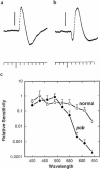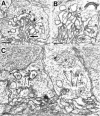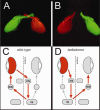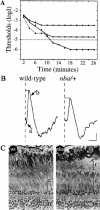Zebrafish: a model system for the study of eye genetics
- PMID: 17962065
- PMCID: PMC2271117
- DOI: 10.1016/j.preteyeres.2007.08.002
Zebrafish: a model system for the study of eye genetics
Abstract
Over the last decade, the use of the zebrafish as a genetic model has moved beyond the proof-of-concept for the analysis of vertebrate embryonic development to demonstrated utility as a mainstream model organism for the understanding of human disease. The initial identification of a variety of zebrafish mutations affecting the eye and retina, and the subsequent cloning of mutated genes have revealed cellular, molecular and physiological processes fundamental to visual system development. With the increasing development of genetic manipulations, sophisticated techniques for phenotypic characterization, behavioral approaches and screening strategies, the identification of novel genes or novel gene functions will have important implications for our understanding of human eye diseases, pathogenesis, and treatment.
Figures






Similar articles
-
The genetics of ocular disorders: insights from the zebrafish.Birth Defects Res C Embryo Today. 2011 Sep;93(3):215-28. doi: 10.1002/bdrc.20211. Birth Defects Res C Embryo Today. 2011. PMID: 21932431 Review.
-
The zebrafish eye-a paradigm for investigating human ocular genetics.Eye (Lond). 2017 Jan;31(1):68-86. doi: 10.1038/eye.2016.198. Epub 2016 Sep 9. Eye (Lond). 2017. PMID: 27612182 Free PMC article. Review.
-
Approaches to study neurogenesis in the zebrafish retina.Methods Cell Biol. 2004;76:333-84. doi: 10.1016/s0091-679x(04)76016-1. Methods Cell Biol. 2004. PMID: 15602883
-
Illuminating cardiac development: Advances in imaging add new dimensions to the utility of zebrafish genetics.Semin Cell Dev Biol. 2007 Feb;18(1):27-35. doi: 10.1016/j.semcdb.2006.12.010. Epub 2006 Dec 27. Semin Cell Dev Biol. 2007. PMID: 17241801 Free PMC article. Review.
-
Hooked! Modeling human disease in zebrafish.J Clin Invest. 2012 Jul;122(7):2337-43. doi: 10.1172/JCI60434. Epub 2012 Jul 2. J Clin Invest. 2012. PMID: 22751109 Free PMC article.
Cited by
-
Animal Models in Eye Research: Focus on Corneal Pathologies.Int J Mol Sci. 2023 Nov 23;24(23):16661. doi: 10.3390/ijms242316661. Int J Mol Sci. 2023. PMID: 38068983 Free PMC article. Review.
-
Electroretinogram analysis of the visual response in zebrafish larvae.J Vis Exp. 2015 Mar 16;(97):52662. doi: 10.3791/52662. J Vis Exp. 2015. PMID: 25867216 Free PMC article.
-
Crk adaptor proteins are necessary for the development of the zebrafish retina.Dev Dyn. 2022 Feb;251(2):362-376. doi: 10.1002/dvdy.402. Epub 2021 Jul 24. Dev Dyn. 2022. PMID: 34268820 Free PMC article.
-
Hmx1 regulates urfh1 expression in the craniofacial region in zebrafish.PLoS One. 2021 Jan 19;16(1):e0245239. doi: 10.1371/journal.pone.0245239. eCollection 2021. PLoS One. 2021. PMID: 33465110 Free PMC article.
-
Action spectra of zebrafish cone photoreceptors.PLoS One. 2013 Jul 5;8(7):e68540. doi: 10.1371/journal.pone.0068540. Print 2013. PLoS One. 2013. PMID: 23861916 Free PMC article.
References
-
- Ahmad I, Dooley CM, Polk DL. Delta-1 is a regulator of neurogenesis in the vertebrate retina. Dev. Biol. 1997;185:92–103. - PubMed
-
- Ahmad I, Tang L, Pham H. Identification of neural progenitors in the adult mammalian eye. Biochem. Biophys. Res. Commun. 2000;270:517–521. - PubMed
-
- Allende ML, Amsterdam A, Becker T, et al. Insertional mutagenesis in zebrafish Identifies two novel genes, pescadillo and dead eye, essential for embryonic development. Genes. Dev. 1996;10:3141–55. - PubMed
-
- Amsterdam A, Hopkins N. Mutagenesis strategies in zebrafish for identifying genes involved in development and disease. Trends Genet. 2006;22:473–478. - PubMed
Publication types
MeSH terms
Grants and funding
LinkOut - more resources
Full Text Sources
Other Literature Sources
Medical

